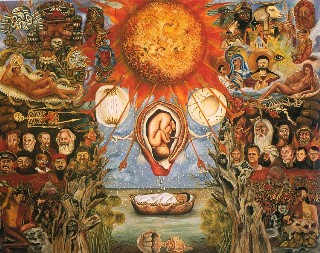Moses
1945
This painting is sometimes referred to as "The Nucleus of Creation". In a written description of this painting, Frida refers to it as "Moses", or "Birth of the Hero".
This masterpiece was commissioned by Don José Domingo Lavin. Kahlo had painted a portrait of Lavin's wife in 1942. Lavin asked Frida to read the Sigmund Freud book "Moses the Man and Monotheistic Religion" and then paint her interpretation of what she had read. This painting was done in the style of a miniature mural…perhaps to copy the works of her famous husband, muralist Diego Rivera. The central figure of the abandoned baby Moses closely resembles Diego, and wears, like Diego in other paintings, the third eye of wisdom on his forehead. The birth is beneath a life giving sun flanked by gods, heroes, common humanity, and the all-embracing hands of death. In the foreground a conch spurting fluid into a concave shell is, Frida said, a symbol of love. Fresh, leafy branches sprouting from dead tree trunks refer to the life/death cycle that appears in many of Frida's paintings.
In 1954, Raquel Tibol, the Mexican art critic, historian and author, interviewed Frida and asked her about this painting and it's relationship to Freud's book "Moses".
"I read the book only once" Frida remarked "and started the painting with my first impression. Later I read it again, and I must confess I found my work most inadequate and quite different from the interpretation Freud analyzes so marvelously in his [book] Moses. But now there's no way to change it…"
It took Frida three
months to complete this painting. For this work Frida was awarded second
prize at the annual art exhibition in the Palacio de Bellas Artes in Mexico.

(Click Here to View Larger Image)
(Pinche aquí para ver la imagen aumentada)
Oil
on masonite
24" x 30"
Private Collection
(On loan to the
Museum of Fine Arts
Houston, TX)
Óleo sobre fibra dura
61 x 75,6 cm.
Colección
privada
(En préstamo al
Museo de Bellas Artes
Houston, TX, EE.UU.)
Moisés
1945
Este cuadro a veces es referido como “El núcleo de la creación”. En una descripción escrita de esta pintura, Frida se refiere a ella como "Moisés", o "Nacimiento del Héroe".
Esta obra maestra fue encargada por Don José Domingo Lavin. Kahlo había pintado un retrato de su esposa en 1942.
Lavin le pidió a Frida que leyera el libro de Sigmund Freud "Moisés, el hombre y la religión monoteísta" y que luego pintara su interpretación de lo que había leído. Esta pintura fue hecha como un mural en miniatura… quizás para adoptar el modo de trabajo de su famoso marido el muralista Diego Rivera. La figura central es el bebé abandonado o Moisés, el cual se parece mucho a Diego, y posee, al igual que Diego en otros retratos, el tercer ojo de la sabiduría en su frente. El nacimiento está representado debajo de un sol, proveedor de vida, y es escoltado por dioses, héroes, la humanidad en general y las manos de la muerte que lo abrazan todo. Abajo, una concha expulsando líquido en la concavidad de otra es, según Frida, un símbolo de amor. Las ramas nuevas con hojas que, brotan de los troncos de árboles muertos se refieren al ciclo de la vida y la muerte que aparece en muchas de las pinturas de Frida.
En 1954, Raquel Tibol, la crítica de arte mexicana, historiadora y autora entrevistó a Frida y le preguntó acerca de esta pintura y su relación con el libro de Freud, "Moisés".
"Leí el libro solo una vez" señaló Frida "y empecé a pintar usando mi primera impresión. Más tarde, lo leí de nuevo y tengo que confesar que encontré mi trabajo muy inadecuado y bastante diferente de la interpretación que Freud analiza tan maravillosamente en su [libro] "Moisés". Pero ahora no hay manera de cambiarlo…"
Frida tardó
tres meses en completar esta pintura. Frida
ganó el segundo premio en una exhibición anual de arte en
el Palacio de Bellas Artes in México con este trabajo.